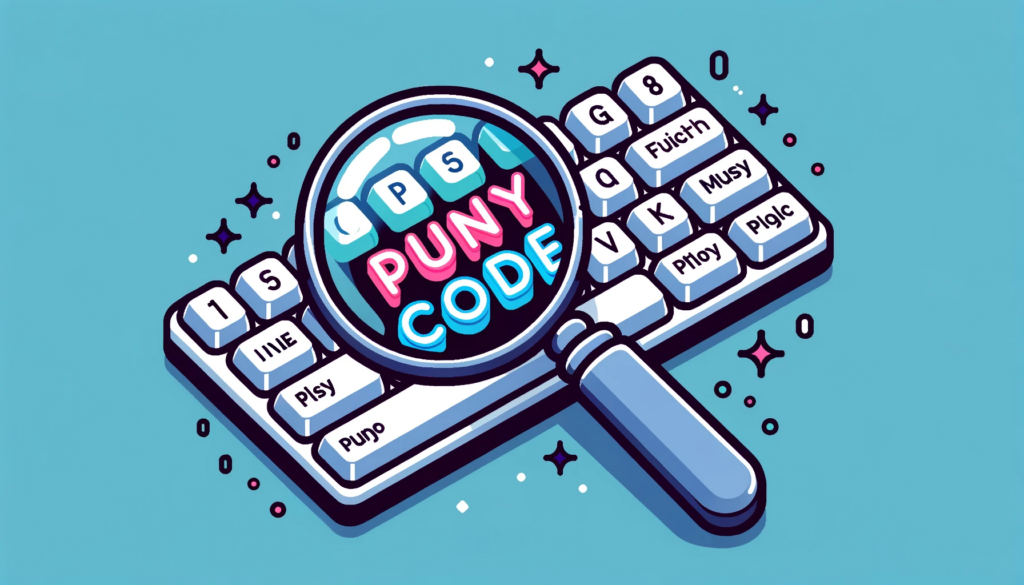
Managing the vast realm of the internet requires a complex system of encoding to ensure that every domain name is unique and universally accessible. What is Punycode and How Does It Work with Domain Names? One such encoding system that plays a pivotal role in this process is Punycode. But what exactly is Punycode, and how does it function in the domain naming system? Let’s dive in and explore this topic in detail.
Key Takeaways:
- Punycode is a unique encoding system that translates Unicode characters into ASCII.
- It’s primarily used for Internationalized Domain Names (IDNs).
- Examples of Punycode domains include “xn--s7y.co” for the Chinese domain “短. co” and “xn--mnchen-3ya” for the German city “München”.
[toc]
What is Punycode?
Punycode is a specialized encoding technique that translates Unicode characters, which can represent almost all of the world’s written languages, into the more limited ASCII character set. ASCII characters are the only ones that can be used in the global Domain Name Scheme (DNS), the naming system for all internet-connected resources.
Imagine you have a box of alphabet blocks, but the blocks only have English letters. Now, if you want to spell a word that has a special character not found in the English alphabet, like “ü”, you’d need a special method to represent that character using only the blocks you have. Punycode is like that method, helping the internet represent special characters using only the basic ASCII characters.
Analogy: Think of Punycode as a translator. If you speak English and you have a friend who speaks only German, you’d need a translator to understand each other. In the world of domain names, Punycode acts as that translator, ensuring that domain names with special characters are understood by the internet’s naming system.
Metaphor: Punycode is like a suitcase that can magically fit any item, no matter its size. Even if you have a giant teddy bear, this suitcase will find a way to pack it compactly. Similarly, Punycode takes large Unicode characters and packs them into a smaller ASCII format.
Why Do We Need Punycode?
The Internet is a global platform, and its users come from diverse linguistic backgrounds. Not all languages can be represented using the standard ASCII characters. This is where Punycode comes into play. It allows domain names to be written in various languages, from Arabic to Chinese, ensuring that the internet is accessible and inclusive.
For instance, the domain name for the German city of “München” would be challenging to represent in ASCII because of the letter “ü”. With Punycode, it becomes “xn--mnchen-3ya”, making it compatible with the domain naming system.
Punycode Domain Examples
To better understand how Punycode works, let’s look at some examples:
- The Chinese domain “短. co” is represented in Punycode as “xn--s7y.co”.
- The German city of “München” is encoded as “xn--mnchen-3ya”.
- The Turkish domain “türkiye.com” becomes “xn--trkiye-3ya.com”.
- The Finnish domain “kourujärvi.fi” is represented as “https://xn--kourujrvi-02a.fi”.
For a visual representation, check out this video on Punycode: https://www.youtube.com/watch?v=jpLR4mnBL_I.
How Does Punycode Work?
Punycode operates by first separating ASCII characters from non-ASCII characters in a domain name. For instance, in the domain “bücher”, the ASCII characters “bcher” are separated, and the non-ASCII character “ü” is encoded. The encoded characters are then represented in a base-36 format, using numbers and letters.
The process might sound complex, but it’s designed to be efficient and to ensure that every domain name, no matter the language, can be represented in a format that the internet’s naming system can understand.
Potential Issues with Punycode
While Punycode is an essential tool for internationalizing domain names, it’s not without its challenges. One of the primary concerns is the potential for phishing attacks. Cybercriminals can create domain names that look very similar to legitimate ones by using Punycode to represent characters that look alike. For instance, the domain “apple.com” could be mimicked using Punycode to represent the letter “a” with a character that looks similar but is different in Unicode.
Users should be cautious and ensure they’re visiting legitimate websites, especially when clicking on links from emails or other untrusted sources.
Managing the vast realm of the internet requires a complex system of encoding to ensure that every domain name is unique and universally accessible. One such encoding system that plays a pivotal role in this process is Punycode. But what exactly is Punycode, and how does it function in the domain naming system? Let’s dive in and explore this topic in detail.
Why Do We Need Punycode?
The Internet is a global platform, and its users come from diverse linguistic backgrounds. Not all languages can be represented using the standard ASCII characters. This is where Punycode comes into play. It allows domain names to be written in various languages, from Arabic to Chinese, ensuring that the internet is accessible and inclusive.
For instance, the domain name for the German city of “München” would be challenging to represent in ASCII because of the letter “ü”. With Punycode, it becomes “xn--mnchen-3ya”, making it compatible with the domain naming system.
Punycode Domain Examples
To better understand how Punycode works, let’s look at some examples:
- The Chinese domain “短. co” is represented in Punycode as “xn--s7y.co”.
- The German city of “München” is encoded as “xn--mnchen-3ya”.
- The Turkish domain “türkiye.com” becomes “xn--trkiye-3ya.com”.
- The Finnish domain “kourujärvi.fi” is represented as “https://xn--kourujrvi-02a.fi”.
For a visual representation, check out this video on Punycode: https://www.youtube.com/watch?v=jpLR4mnBL_I.
How Does Punycode Work?
Punycode operates by first separating ASCII characters from non-ASCII characters in a domain name. For instance, in the domain “bücher”, the ASCII characters “bcher” are separated, and the non-ASCII character “ü” is encoded. The encoded characters are then represented in a base-36 format, using numbers and letters.
The process might sound complex, but it’s designed to be efficient and to ensure that every domain name, no matter the language, can be represented in a format that the internet’s naming system can understand.
Potential Issues with Punycode
While Punycode is an essential tool for internationalizing domain names, it’s not without its challenges. One of the primary concerns is the potential for phishing attacks. Cybercriminals can create domain names that look very similar to legitimate ones by using Punycode to represent characters that look alike. For instance, the domain “apple.com” could be mimicked using Punycode to represent the letter “a” with a character that looks similar but is different in Unicode.
Users should be cautious and ensure they’re visiting legitimate websites, especially when clicking on links from emails or other untrusted sources.
Encoding and Decoding with Punycode
Punycode is a representation of Unicode with the limited ASCII character subset used for Internet hostnames. Using Punycode, host names containing Unicode characters are transcoded to a subset of ASCII consisting of letters, digits, and hyphens, which is called the letter–digit–hyphen (LDH) subset. For example, München (the German name for Munich) is encoded as Mnchen-3ya.
The Domain Name System (DNS) technically supports arbitrary sequences of octets in domain name labels. However, the DNS standards recommend the use of the LDH subset of ASCII conventionally used for host names. The Punycode syntax is a method of encoding strings containing Unicode characters, such as internationalized domain names (IDNA), into the LDH subset of ASCII favored by DNS.
How Does Punycode Work?
Punycode is an instance of a more general algorithm called Bootstring. This algorithm allows strings composed from a small set of ‘basic’ code points to uniquely represent any string of code points drawn from a larger set. Punycode defines parameters for the general Bootstring algorithm to match the characteristics of Unicode text.
Why is Punycode Important?
Punycode is crucial for ensuring that domain names can be represented in a format that is compatible with the DNS. Without Punycode, it would be impossible to represent internationalized domain names in the DNS, which would limit the global reach of the internet.
Potential Risks with Punycode
While Punycode serves a valuable purpose, it’s not without its potential risks. Cybercriminals can use Punycode to create phishing websites with domain names that look legitimate but are, in fact, deceptive. For instance, they might use Punycode to register a domain that visually resembles a well-known brand, tricking users into thinking they’re visiting a legitimate site.
How to Protect Yourself
To protect yourself from potential Punycode phishing attacks:
- Always double-check the URL in your browser’s address bar.
- Use browsers that alert you to potential Punycode phishing attempts.
- Regularly update your browser to ensure you have the latest security patches.
Punycode in Modern Browsers
Modern web browsers have implemented measures to detect and warn users about potential Punycode phishing attempts. For instance, if a domain name has characters from multiple languages, the browser might display the Punycode version of the domain to alert the user to the potential risk.
The Future of Punycode
As the internet continues to evolve and become more inclusive, the importance of Punycode will likely increase. As more languages and scripts are added to the Unicode standard, the need for a system like Punycode to represent them in the DNS will grow.
Remember, while Punycode is a powerful tool for representing internationalized domain names, it’s essential to be aware of its potential risks and stay protected.



